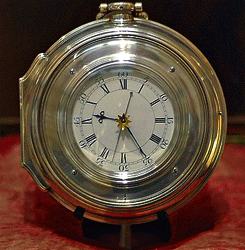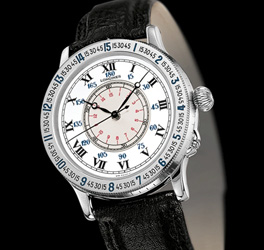Up until then wristwatches were generally something worn only by women, men preferring pocket watches. However soldiers in World War I soon realised that in the heat of battle its much faster and safer to quickly glance at a wristwatch than hauling out the much larger pocket watch from under a greatcoat, an action which could also get you killed. This led to the need for military watches that could be worn on the wrist, or wristwatches.
Early Development
The need for a reliable way to measure longitude led to the development of the first military timepiece, a naval chronometer.
Up until the mid 1750’s navigation at sea was difficult because of the inability to reliably calculate longitude (Latitude could be determined by measuring the suns angle at mid-day). So In 1714 the British Government decided to offer a huge reward of 20,000 pounds to the person who could come up with an invention to accurately and reliably calculate longitude.

The first military timepiece, the Harrison Marine Chronometer.
John Harrison, a Yorkshire carpenter and self-taught watchmaker discovered that to correctly measure longitude, the precise time needed to be known. However creating a timepiece that was accurate on board a ship was difficult. Up until that time the most accurate timekeepers were pendulum clocks, however gravity-based pendulums were useless onboard a ship.
So Harrison resolved to develop a timepiece more accurate than anything available at the time as well as being seaworthy by counteracting the effects of centrifugal force. He spent ten years constructing four different versions until eventually in 1761 he submitted and won the 20,000 pound reward with his fourth version, what was to become known as the Harrison Marine Chronometer (Pictured above). It was to become the most important watch of its day, the foundation for nautical navigation.
Improvisation and modification
The innovation of watches through military necessity began in the nineteenth century when soldiers started modifying their pocket watches so that they could be worn on their wrists by fitting them with makeshift cupped leather holders and straps and turning them into improvised military watches.
British Officers in the Boer war took advantage of these improvised military wristwatches to gain greater precision in the directing and organising of troop movement. They found them to be useful in strategic planning particularly in the sychronization of flanking attacks.
Further modifications were made, in order to protect the watch glass during combat, metal covers were added called “Shrapnel Guards”. These covers often made of Silver, encased the dial and glass and had appropriately placed cutaways to allow easy readability.

Early shrapnel guard Advertisement
Pilot watches
During the Second World War further technological advancements to military watches were made.
In Aviation “Pilot” or “Navigator” watches were born. Pilot watches were developed due to the need in Aviation for the precise measurement of seconds, to achieve this, watches were fitted with a “seconds bezel”.
Split second timing is crucial for military watches, especially in aviation since a deviation of only a few seconds could lead to huge navigational errors. So the seconds bezel was an important addition. It aided in navigation because the pilot could use this bezel to synchronize with the correct reference time before taking off. It was also useful for making adjustments to radio time signals whilst in flight so that “chronometer errors” and consequently navigational errors could be avoided.


The Longines “Weems” with seconds bezel and center seconds. And the Lindbergh “Hour Angle”
source Longines
The Longines “Weems” pictured above released in 1929, was the first wristwatch specifically designed for aeronautical navigation. Named Weems after Professor Philip Weems of the US Naval Academy with whom Longines collaborated with on the watch’s design. Later in 1932 Longines would team up with famous aviator Charles Lindbergh to create their further improved “Hour Angle” watch (right)
